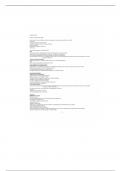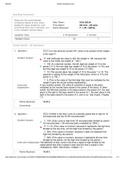KEYPOINTS
Harnessing creativity
Inhoud
Week 1...................................................................................................................................................4
Conclusions from the lecture video:...............................................................................................4
Conclusions from the TED talk: do schools kill creativity?..............................................................6
Conclusions from the TED talk: how to build your creative confidence..........................................6
Conclusions from the article: Defining and measuring creativity: Are creativity tests worth using?
By Arthur J. Cropley........................................................................................................................6
Conclusions from the Tuesday-workshop:......................................................................................6
Week 2...................................................................................................................................................8
Conclusions from the lecture video:...............................................................................................8
Conclusions from Monday’s session:............................................................................................10
Conclusions from Tuesday’s session:............................................................................................10
Conclusions from Thursday’s session:..........................................................................................11
Conclusions from “Case – What’s stifling creativity at CoolBurst?”..............................................11
Conclusions from “The nature of creativity: the roles of genetic factors, personality traits,
cognitive abilities and environmental sources”............................................................................12
Conclusions from “How to kill creativity”.....................................................................................14
Week 3.................................................................................................................................................15
Conclusions from the lecture video:.............................................................................................15
Conclusions from the article “Integrating problem solvers from analogous markets in new
product ideation”:........................................................................................................................18
Conclusions from the article “The hidden traps in decision making”...........................................18
Conclusions from the article “The dual pathway to creativity model: creative ideation as a
function of flexibility and persistence”.........................................................................................20
Conclusions from the Monday session:........................................................................................21
Conclusions from the Tuesday session:........................................................................................21
Week 4.................................................................................................................................................22
Conclusions from the lecture video:.............................................................................................22
Conclusions from the article: let's dance! elastic coordination in creative group work: a
qualitative study of modern dancers............................................................................................25
Conclusions from the article: Improving the creativity of organizational work groups................26
Conclusions from the article: brainstorming, brainstorming rules and decision making..............30
Week 5.................................................................................................................................................33
Conclusions from the lecture video:.............................................................................................33
1
, KEYPOINTS – MINOR HARNESSING CREATIVITY – 19/10/2021
Conclusions from the article: What Leaders need to know A review of social and contextual
factors that can foster or hinder creativity...................................................................................35
Conclusions on the article: The Role of the Physical Environment in Supporting Organizational
Creativity......................................................................................................................................38
Conclusions on the article: Knowledge workers’ creativity and the role of the physical work
environment.................................................................................................................................41
Week 6.................................................................................................................................................47
Conclusions on the article: Brown, T. (2008). Design thinking......................................................49
Conclusions on the article: Liedtka, J. (2015). Perspective: Linking design thinking with
innovation outcomes through cognitive bias reduction...............................................................53
Conclusions on the article: Thompson, L. and Schonthal, D. (2020). The social psychology of
design thinking.............................................................................................................................56
Conclusions on Tuesday’s session (workshop):............................................................................58
Week 7.................................................................................................................................................59
Conclusions on the (introduction) lecture:...................................................................................59
Conclusions on the article by Mueller et al (2012): The Bias Against Creativity Why People desire
but reject creative ideas...............................................................................................................60
Conclusions on the article by Berg (2016): Balancing on the creative highwire: Forecasting the
success of novel ideas in organizations.........................................................................................61
Conclusions on the article by Fuchs et al (2019): The ideator’s bias: How identity-induced self-
efficacy drives overestimation in employee-driven process innovation.......................................66
Week 8.................................................................................................................................................69
Conclusions on the lecture video: communicating creative ideas................................................69
Conclusions on the article: Cialdini (2008) Harnessing The Science Of Persuasion.......................72
Conclusions on the article: Lu (2019) Pitching novel ideas to the boss: the interactive effects of
employees’ idea enactment and influence tactics on creativity assessment and implementation
......................................................................................................................................................73
Conclusions on article: Lee (2017) How do I get my way? A meta-analytic review of research on
influence tactics............................................................................................................................78
List of concepts.....................................................................................................................................84
Week 1..........................................................................................................................................84
Week 2..........................................................................................................................................84
Week 3..........................................................................................................................................84
Week 4..........................................................................................................................................84
Week 5..........................................................................................................................................85
Week 6..........................................................................................................................................85
Week 7..........................................................................................................................................86
Week 8..........................................................................................................................................86
2
,KEYPOINTS – MINOR HARNESSING CREATIVITY – 19/10/2021
3
, KEYPOINTS – MINOR HARNESSING CREATIVITY – 19/10/2021
Week 1
Conclusions from the lecture video:
There are many different methods to measure creativity. Generally there are 4 categories:
PRODUCT PROCESS MOTIVATION PERSONALITY
Novelty Fluency Risk taking Flexibility
Usefulness Problem recognition Liking complexity Curiosity
Relevance Combination Liking asymmetry Independence
Complexity Recognition Asking questions Imagination
Understandability Elaboration Crossing borders
Pleasingness Developing ideas
Elegance
Germinality
The most important measures are novelty and usefulness
Definition of creativity: process of generating novel and useful ideas or solutions
- Novel:
o Fluency: number of ideas generated
o Flexibility: cover a range of categories
o Originality: uniqueness/rarity
- Useful:
o Valuable: effective, worthwhile, successful
o Feasible: practical, able to be implemented
Ideas can either be incremental or radical
Incremental ideas Radical ideas
Small improvements to products e.g. A product that appears to be doing
fixing defects, making things faster, everything wrong, has defects and lower
cheaper etc. performance
Low novelty and high initial usefulness High novelty and low initial usefulness
Sustains customers current needs Forecasts new needs
Guaranteed short term rewards Uncertain but potentially greater long
term rewards
Products often go through cycles of development.
Radical and incremental change both take place in
during this cycle.
A cycle can often be described like this:
there is technological discontinuity because of a
radically new idea. A product is formed. Then follows
the era of ferment, there is a lot of competition on
what the design of the product is going to be like. This
phase is chaotic, and meant to find out what works
and what doesn’t. This phase is followed by
4
, KEYPOINTS – MINOR HARNESSING CREATIVITY – 19/10/2021
convergence on a dominant design. Then the era of incremental change starts. The dominant design
is refined. This cycle can then again be disrupted by radical ideas.
The s-curve limit can mean that a company might no
longer survive / remain profitable by just making
incremental changes.
People tend to prefer incremental ideas over radical ideas. They also tend to stick with decisions
they’ve already made.
How do you achieve radical creativity?
The most reliable predictor of an idea’s creative quality (novelty + usefulness) is idea quantity.
Generating a large quantity of ideas increases the likelihood that:
- one of those ideas is truly novel
- after generating a few ideas you exhaust conventional options and generate unconventional
solutions
So: idea quantity often leads to idea quality
Research has shown the differences between creative vs. uncreative organisations.
5
, KEYPOINTS – MINOR HARNESSING CREATIVITY – 19/10/2021
Conclusions from the TED talk: do schools kill creativity?
Ons schoolsysteem focust heel erg op bepaalde zaken (zoals wiskunde, geletterdheid) die
studenten/kinderen geschikt maken voor een baan zoals de industriële revolutie die ging aanbieden.
Onze scholen stomen kinderen klaar voor professor functies.
We putten breinen uit voor maar een paar soorten grondstof: dingen zoals taalknobbels,
wiskundeknobbels, etc. Dit is niet sustainable om een toekomst mee te creëren.
Creativiteit moet net zo belangrijk worden als wiskunde. Kinderen verschillen ontzettend en dat
moeten we meer accommoderen. Scholen moeten hun best gaan doen om creativiteit te behouden,
niet de kop in gaan drukken.
Want om een toekomst te creëren hebben we heel veel creatieve mensen nodig.
Conclusions from the TED talk: how to build your creative confidence
You don’t do things if you are afraid you’re gonna be judged
Guided mastery: overcoming fears in little steps of confrontation
The world is not divided in creative and non-creative people. We should help people realise that they
are already creative, but that they have to let that speak to themselves.
Conclusions from the article: Defining and measuring creativity: Are
creativity tests worth using? By Arthur J. Cropley
There are very many tests to test creativity.
“Focus on a multidimensional concept of creativity, on assessment of potential and on the use of
tests as a basis for differentiated counselling suggests that creativity tests are worth using.”
“Creativity tests are best thought of as tests of creative potential, not of creativity.”
“Among tests of creative thinking the TTCT-DP has much to recommend it. It is based on a more
general theory of creativity than the relatively ad hoc test-derived models centering on divergent
thinking (Torrance) or divergent production (Guilford), and encompasses both thinking and
personality.”
In this article previously mentioned categories (product, process, motivation and personality) are also
mentioned multiple times.
Conclusions from the Tuesday-workshop:
Brainstorming is early stage idea generation. The main goal is idea quantity.
Creating a large quantity of ideas can get you past a creative block.
The later ideas are often of higher quality.
6











